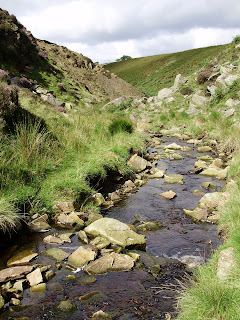 I'm sure I'm not the only person that enjoys tree spotting as I drive along the road. Once you get an eye for basic tree shapes and features, you can name many at a glance. To me, ash trees (left) are a bit snooty! Why? Because their twigs tend to curl upwards. Whereas beech tend to have horizontally spreading branches. Many have distinctive shapes and colours - I'll try photograph more another day.
I'm sure I'm not the only person that enjoys tree spotting as I drive along the road. Once you get an eye for basic tree shapes and features, you can name many at a glance. To me, ash trees (left) are a bit snooty! Why? Because their twigs tend to curl upwards. Whereas beech tend to have horizontally spreading branches. Many have distinctive shapes and colours - I'll try photograph more another day.A crisp tree shape against a cerulean sky - how many beautiful sights we have on winter days.
Since my camera isn't good enough to photograph birds, I've decided to share some tree shapes with you from a weekend walk around Croston. How complex is this willow trunk below?

How useful telegraph poles are in sparing a few extra berries for hungry redwings....
 At this time of year, I also enjoy the contrast between frozen and non-frozen patches.
At this time of year, I also enjoy the contrast between frozen and non-frozen patches. 
And if you get close, have a look at just how brightly coloured lichen can be.
 But let's not forget the birds. I really enjoyed watching the yellowhammers, their faces bright like summer suns. There were lots of roaming fieldfare in small parties and one had approaching 100 birds. A snipe was flushed from a ditch and two lapwings had returned to the fields to try their luck where the frost was melting. Amongst the stubble was a flock of about 100 larks, calling as they rose before plunging back into silence and more stubble. There was also a small flock of linnet, tree sparrows at several sites, reed bunting,buzzard, kestrels and lots of garden birds.
But let's not forget the birds. I really enjoyed watching the yellowhammers, their faces bright like summer suns. There were lots of roaming fieldfare in small parties and one had approaching 100 birds. A snipe was flushed from a ditch and two lapwings had returned to the fields to try their luck where the frost was melting. Amongst the stubble was a flock of about 100 larks, calling as they rose before plunging back into silence and more stubble. There was also a small flock of linnet, tree sparrows at several sites, reed bunting,buzzard, kestrels and lots of garden birds.



 This charming horse and fox really made me smile. It's obvious whose side the horse is on.
This charming horse and fox really made me smile. It's obvious whose side the horse is on.







 I enjoy the landscape of this brook, looking at angles of the carved valley and its tributaries.
I enjoy the landscape of this brook, looking at angles of the carved valley and its tributaries. 

 Emerald Damselfly by David Kitching
Emerald Damselfly by David Kitching  Common Hawker by Mathew Webster dragonflysoc.org.uk
Common Hawker by Mathew Webster dragonflysoc.org.uk
 We decided to enjoy the sun and showers by taking a walk around Stocks Reservoir. It's a 11km / 7m circular walk which is well signed. Close to our start point is a United Utilities office - don't they just own some beautiful buildings?
We decided to enjoy the sun and showers by taking a walk around Stocks Reservoir. It's a 11km / 7m circular walk which is well signed. Close to our start point is a United Utilities office - don't they just own some beautiful buildings?  Soon we pass the Valve Tower (above). The reservoir is low at present due to less than average rainfall but when we notice that even the culverts near the reservoir are not being cleared, it begs the question: is the precious rainfall being captured efficiently in these catchment areas?
Soon we pass the Valve Tower (above). The reservoir is low at present due to less than average rainfall but when we notice that even the culverts near the reservoir are not being cleared, it begs the question: is the precious rainfall being captured efficiently in these catchment areas?  We see several oystercatchers. One of the joys of this walk in summer is the flowers. Everywhere fields are pitted by the purple heads of black
We see several oystercatchers. One of the joys of this walk in summer is the flowers. Everywhere fields are pitted by the purple heads of black 
 The sunny spells encourage butterflies to rise and we see mostly green-veined whites and meadow browns. We also disturb a cloud of larks and are greeted by another favourite flower of mine -
The sunny spells encourage butterflies to rise and we see mostly green-veined whites and meadow browns. We also disturb a cloud of larks and are greeted by another favourite flower of mine -  Now we veer from the reservoir through fields and a bridge to cross Hasgill Beck and the River Hodder which feed the reservoir. More lambs and flowers. Much of the return walk follows a dismantled railway line and I wonder what it must have been like to travel such a scenic route.
Now we veer from the reservoir through fields and a bridge to cross Hasgill Beck and the River Hodder which feed the reservoir. More lambs and flowers. Much of the return walk follows a dismantled railway line and I wonder what it must have been like to travel such a scenic route.


